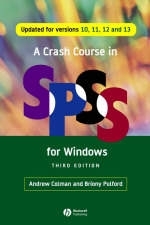
A Crash Course in SPSS for Windows
Blackwell Publishing Ltd (Verlag)
978-1-4051-4531-2 (ISBN)
- Titel ist leider vergriffen;
keine Neuauflage - Artikel merken
This simple, user-friendly introduction to SPSS for Windows has now been updated so that it can be used with versions 10, 11, 12 and 13 of the software. It clearly describes all the most widely used statistical techniques and graphic facilities in SPSS for Windows. It includes two new chapters on recoding variables and handling large data files, and using SPSS syntax, and a new appendix discussing procedures for exporting and importing Excel files and is supported by an online resource site featuring downloadable data sets and additional examples from various social science disciplines.
Briony D. Pulford, Lecturer in Psychology at the University of Leicester, is an experienced researcher and data analyst. She has published extensively in academic journals, and has taught undergraduates how to use SPSS over many years. Andrew M. Colman is Professor of Psychology at the University of Leicester and an Academician of the Social Sciences. His previous publications include numerous journal articles and several books, including the Oxford Dictionary of Psychology (2001, 2006).
Preface to the Third Edition.Choosing an Appropriate Statistical Procedure.Where to Find Things in SPSS.1. Introduction.2. Using Windows.2.1 Running SPSS for Windows.2.2 Resizing and moving a window.2.3 The Data Editor.2.4 Entering data.2.5 Scrolling.2.6 Saving data.2.7 Exiting SPSS for Windows.3. Loading Data and Printing.3.1 Loading data.3.2 Printing an entire data set.3.3 Printing a selection of data.4. General Descriptive Statistics.4.1 Analysing data.4.2 Means, standard deviations, and other measures.4.3 Cutting and pasting.4.4 Pasting data into a Word document.5. Correlation Coefficients.5.1 Background.5.2 Pearson's correlation coefficient.5.3 Spearman's rho.6. Chi-square Tests.6.1 Background.6.2 The chi-square test of association.6.3 Naming variables and labelling values.6.4 Data input and analysis.6.5 The chi-square goodness-of-fit test.7. Independent-samples, Paired-samples, and One-sample t Tests.7.1 Background.7.2 The independent-samples t test.7.3 The paired-samples t test.7.4 The one-sample t test.8. Mann-Whitney U and Wilcoxon Matched-pairs Tests.8.1 Background.8.2 The Mann-Whitney U test.8.3 The Wilcoxon matched-pairs test.9. One-way Analysis of Variance.9.1 Background.9.2 Data input.9.3 Analysis.9.4 Results.10. Multifactorial Analysis of Variance.10.1 Background.10.2 Data input.10.3 Analysis.10.4 Results.11. Repeated-measures Analysis of Variance.11.1 Background.11.2 Data input.11.3 Analysis.11.4 Results.12. Multiple Regression.12.1 Background.12.2 Data input.12.3 Analysis.12.4 Results.13. Log-linear Analysis.13.1 Background.13.2 Data input.13.3 Analysis.13.4 Results.14. Factor Analysis.14.1 Background.14.2 Data input.14.3 Analysis.14.4 Results.15. Charts and Graphs.15.1 Background.15.2 Bar charts.15.3 Pie charts and simple line graphs.15.4 Multiple line graphs.15.5 Scatterplots.16. Handling Variables and Large Data Files.16.1 Recoding to create new variables.16.2 Computing new variables.16.3 Handling large data files.17. Syntax Windows.17.1 Background.17.2 A worked example.17.3 Some syntax procedures.Appendix 1: Handling Dates.Appendix 2: Exporting and Importing Excel Files.References.Index
| Erscheint lt. Verlag | 10.3.2006 |
|---|---|
| Zusatzinfo | 132 illustrations |
| Verlagsort | Oxford |
| Sprache | englisch |
| Maße | 185 x 241 mm |
| Gewicht | 408 g |
| Themenwelt | Mathematik / Informatik ► Mathematik ► Computerprogramme / Computeralgebra |
| ISBN-10 | 1-4051-4531-5 / 1405145315 |
| ISBN-13 | 978-1-4051-4531-2 / 9781405145312 |
| Zustand | Neuware |
| Informationen gemäß Produktsicherheitsverordnung (GPSR) | |
| Haben Sie eine Frage zum Produkt? |
aus dem Bereich


